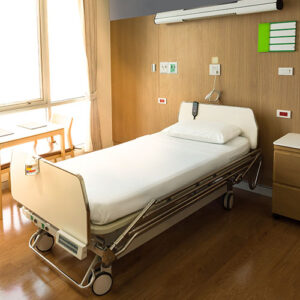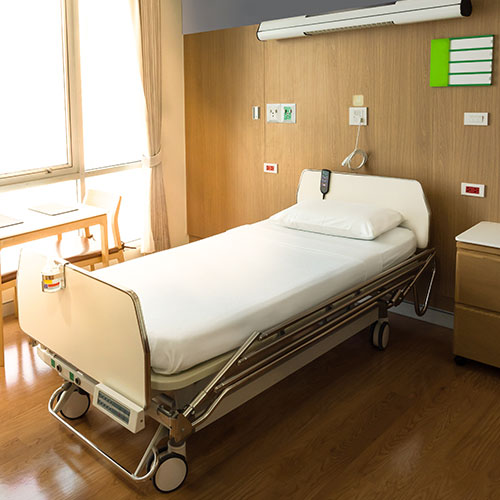 Medical equipment manufacturers must deliver devices that are easy to use, meet rigorous safety standards, and promote patient comfort and well-being. Yet, these crucial machines can sometimes be loud and uncomfortable. Depending on a manufacturer’s needs, a traditional die-cut acoustic foam solution may be sufficient to absorb the noise generated by the equipment. But some projects have very unique energy management challenges that require a custom solution.
Medical equipment manufacturers must deliver devices that are easy to use, meet rigorous safety standards, and promote patient comfort and well-being. Yet, these crucial machines can sometimes be loud and uncomfortable. Depending on a manufacturer’s needs, a traditional die-cut acoustic foam solution may be sufficient to absorb the noise generated by the equipment. But some projects have very unique energy management challenges that require a custom solution.
At Polymer Technologies, our custom molded foams are designed to absorb noise and stop vibration at the source, streamlining assembly and enhancing equipment performance in hospitals. Our Molded Product Division, PMP, develops tailored solutions to a product’s specifications for sound attenuation, vibration isolation, and thermal control. The molded foams we develop are made of open cell polyurethane materials that can be formed into nearly any 3D shape to reduce noise and ensure proper airflow for a range of medical devices. We’ll explore how custom molded foam can support hospital equipment performance and safety while simplifying the production process for manufacturers.
Challenges Medical Device Manufacturers Face
Our engineers work with many different medical applications, including oxygen concentrators, blood analysis equipment, motorized hospital beds, and surgical smoke evacuation machines. Many discussions start with a goal of reducing noise and vibration generated by the device. For example, blowers, motors, compressors, pumps, and other internal components can make an oxygen concentrator or ventilator very noisy and uncomfortable to use.
And in healthcare settings, that’s on top of an already loud environment. A Johns Hopkins Hospital study found daily average sound levels of 50–60 dBA across the hospital. Loud noise levels can disturb medical staff and make it more difficult to concentrate and communicate. Even worse, increased noise exposure has been associated with increased anxiety, poor sleep, and other adverse patient outcomes.
While noise is often the initial trigger, manufacturers’ challenges frequently extend beyond a single issue. They might be dealing with a costly or time-consuming assembly process, an excess of parts for traditional insulation, or even overheating and usability issues. Molded foam can provide a solution to all these problems.
How Does Molded Foam Support Medical Equipment Applications?
Custom molded foam offers medical device manufacturers a versatile solution for managing noise, vibration, and temperature while improving equipment quality and performance. It is engineered to fit tight and complex enclosures within the device. This ensures complete coverage for these lightweight, open cell materials to absorb sound and damp vibration far better than a plastic or metal cover alone. They can also act as an internal chassis to enhance structural integrity and provide a thermal barrier.
By combining multiple functions into a single component, molded foam eliminates the need for fasteners, screws, and multiple separate parts—simplifying assembly, reducing labor, and making inventory management easier. While a molded foam solution may be initially more expensive than flat foam, these efficiencies may help to reduce the overall cost of production, delivering a better ROI.
With little assembly required, a long application life, and the ability to enhance both performance and durability, custom molded foam helps manufacturers streamline production while delivering better, quieter hospital equipment.
Our Custom Molded Foam Materials
At Polymer Technologies, we specialize in providing custom molded foam solutions, specifically engineered for the high demands of the medical industry. Here are three products from our POLYFORM® line that demonstrate how we meet our customers’ rigorous requirements.
POLYFORM® High-Density Molded Foam – Integral Skin (PHDM-IS) is a self-skinning flexible foam with a density of 10–20 lb/ft³. This polyurethane foam features an integral, high-density skin that offers excellent abrasion resistance, high tear strength, and low water absorption.
POLYFORM® High-Density Molded Foam – Non Skinned (PHDM-NS) is an open cell flexible foam with a density of 10–20 lb/ft³. This material provides high resilience, good tear strength, and good elongation properties. It is formulated for low emissions and non-staining end-use requirements.
POLYFORM® Low-Density Molded Foam – High Resilient (PLDM-HR) is a non-skinning open cell foam with a density of 3–6 lb/ft³. It provides high resilience, low fatigue loss, and good cushioning quality. It is suitable for absorbing mid to high-frequency sound waves.
How We Made a Hospital Bed Mattress Inflator Quieter
To give you a better idea of our capabilities, we wanted to spotlight a real-world solution for a medical device manufacturer. We helped a company solve a significant design challenge with their hospital bed mattress inflator. The device’s internal blower produced a loud overall noise of 55 dBA with irritating frequency spikes, disturbing patients and hospital staff.
The original solution was inefficient and complex, using ten separate die-cut foam pieces that required three different dies to produce. This assembly process was time-consuming and costly, yet it failed to solve the noise problem.
We stepped in and developed a custom, two-piece POLYFORM® molded foam insert. This innovative solution was engineered to fully encapsulate the blower, providing comprehensive acoustical absorption and vibration isolation.
The results were transformative:
Noise: The overall sound level was reduced from 55 dBA to 50 dBA, and the frequency spikes were significantly decreased, resulting in a quieter, more pleasant-sounding device.
Parts: The 10 die-cut foam pieces were replaced by a single, two-piece molded foam insert, simplifying the cost of materials and inventory.
Assembly: The time required for installation was reduced by 40%, making the manufacturing process faster, more efficient, and less prone to error.
This project was a prime example of how a custom molded foam solution can not only solve a specific problem but also improve a product’s overall design and manufacturing process while ensuring a better patient experience.
We have worked on many other projects in the medical industry with similar results, including reducing noise for an oxygen concentrator and improving the assembly process for a respiratory device.
If you are looking at ways to improve the functionality and performance of your medical device, contact our team today. Our engineers will review your specific needs to develop and recommend a foam solution that will transform your product’s performance and assembly.


